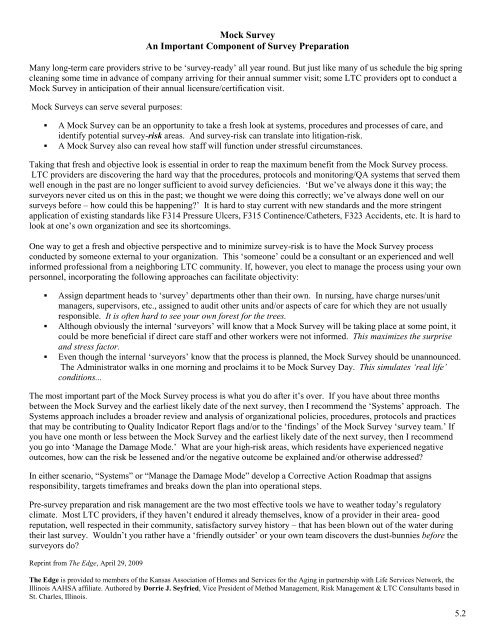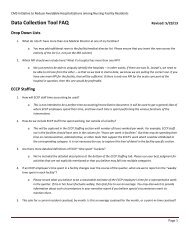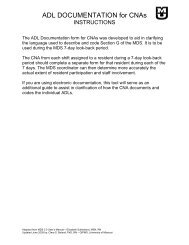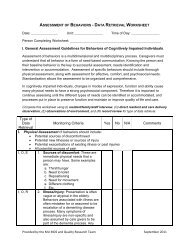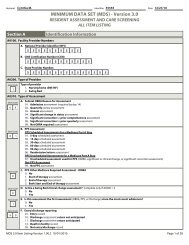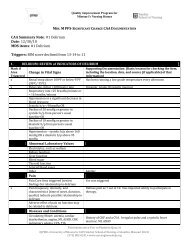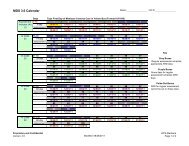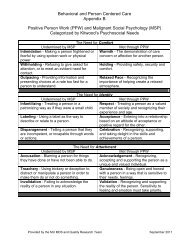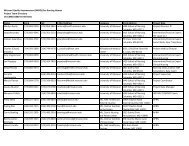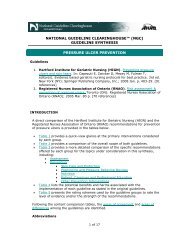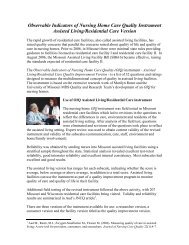Facility Self-Assessment (Mock Survey) Tool - Nursing Home Help
Facility Self-Assessment (Mock Survey) Tool - Nursing Home Help
Facility Self-Assessment (Mock Survey) Tool - Nursing Home Help
You also want an ePaper? Increase the reach of your titles
YUMPU automatically turns print PDFs into web optimized ePapers that Google loves.
<strong>Mock</strong> <strong>Survey</strong><br />
An Important Component of <strong>Survey</strong> Preparation<br />
Many long-term care providers strive to be ‘survey-ready’ all year round. But just like many of us schedule the big spring<br />
cleaning some time in advance of company arriving for their annual summer visit; some LTC providers opt to conduct a<br />
<strong>Mock</strong> <strong>Survey</strong> in anticipation of their annual licensure/certification visit.<br />
<strong>Mock</strong> <strong>Survey</strong>s can serve several purposes:<br />
• A <strong>Mock</strong> <strong>Survey</strong> can be an opportunity to take a fresh look at systems, procedures and processes of care, and<br />
identify potential survey-risk areas. And survey-risk can translate into litigation-risk.<br />
• A <strong>Mock</strong> <strong>Survey</strong> also can reveal how staff will function under stressful circumstances.<br />
Taking that fresh and objective look is essential in order to reap the maximum benefit from the <strong>Mock</strong> <strong>Survey</strong> process.<br />
LTC providers are discovering the hard way that the procedures, protocols and monitoring/QA systems that served them<br />
well enough in the past are no longer sufficient to avoid survey deficiencies. ‘But we’ve always done it this way; the<br />
surveyors never cited us on this in the past; we thought we were doing this correctly; we’ve always done well on our<br />
surveys before – how could this be happening?’ It is hard to stay current with new standards and the more stringent<br />
application of existing standards like F314 Pressure Ulcers, F315 Continence/Catheters, F323 Accidents, etc. It is hard to<br />
look at one’s own organization and see its shortcomings.<br />
One way to get a fresh and objective perspective and to minimize survey-risk is to have the <strong>Mock</strong> <strong>Survey</strong> process<br />
conducted by someone external to your organization. This ‘someone’ could be a consultant or an experienced and well<br />
informed professional from a neighboring LTC community. If, however, you elect to manage the process using your own<br />
personnel, incorporating the following approaches can facilitate objectivity:<br />
• Assign department heads to ‘survey’ departments other than their own. In nursing, have charge nurses/unit<br />
managers, supervisors, etc., assigned to audit other units and/or aspects of care for which they are not usually<br />
responsible. It is often hard to see your own forest for the trees.<br />
• Although obviously the internal ‘surveyors’ will know that a <strong>Mock</strong> <strong>Survey</strong> will be taking place at some point, it<br />
could be more beneficial if direct care staff and other workers were not informed. This maximizes the surprise<br />
and stress factor.<br />
• Even though the internal ‘surveyors’ know that the process is planned, the <strong>Mock</strong> <strong>Survey</strong> should be unannounced.<br />
The Administrator walks in one morning and proclaims it to be <strong>Mock</strong> <strong>Survey</strong> Day. This simulates ‘real life’<br />
conditions...<br />
The most important part of the <strong>Mock</strong> <strong>Survey</strong> process is what you do after it’s over. If you have about three months<br />
between the <strong>Mock</strong> <strong>Survey</strong> and the earliest likely date of the next survey, then I recommend the ‘Systems’ approach. The<br />
Systems approach includes a broader review and analysis of organizational policies, procedures, protocols and practices<br />
that may be contributing to Quality Indicator Report flags and/or to the ‘findings’ of the <strong>Mock</strong> <strong>Survey</strong> ‘survey team.’ If<br />
you have one month or less between the <strong>Mock</strong> <strong>Survey</strong> and the earliest likely date of the next survey, then I recommend<br />
you go into ‘Manage the Damage Mode.’ What are your high-risk areas, which residents have experienced negative<br />
outcomes, how can the risk be lessened and/or the negative outcome be explained and/or otherwise addressed?<br />
In either scenario, “Systems” or “Manage the Damage Mode” develop a Corrective Action Roadmap that assigns<br />
responsibility, targets timeframes and breaks down the plan into operational steps.<br />
Pre-survey preparation and risk management are the two most effective tools we have to weather today’s regulatory<br />
climate. Most LTC providers, if they haven’t endured it already themselves, know of a provider in their area- good<br />
reputation, well respected in their community, satisfactory survey history – that has been blown out of the water during<br />
their last survey. Wouldn’t you rather have a ‘friendly outsider’ or your own team discovers the dust-bunnies before the<br />
surveyors do?<br />
Reprint from The Edge, April 29, 2009<br />
The Edge is provided to members of the Kansas Association of <strong>Home</strong>s and Services for the Aging in partnership with Life Services Network, the<br />
Illinois AAHSA affiliate. Authored by Dorrie J. Seyfried, Vice President of Method Management, Risk Management & LTC Consultants based in<br />
St. Charles, Illinois.<br />
5.2



